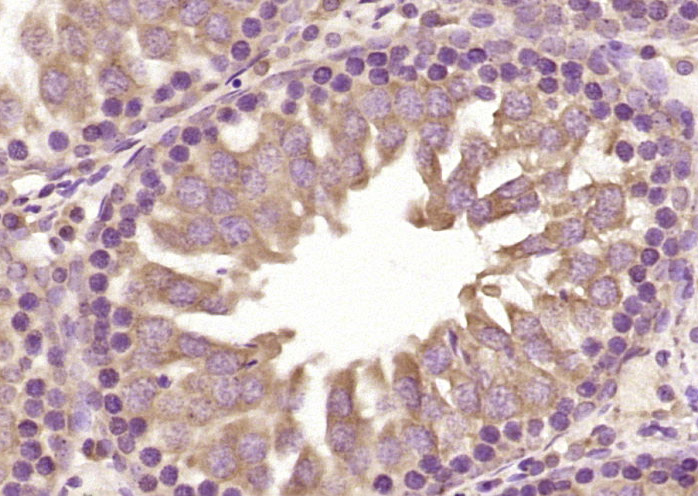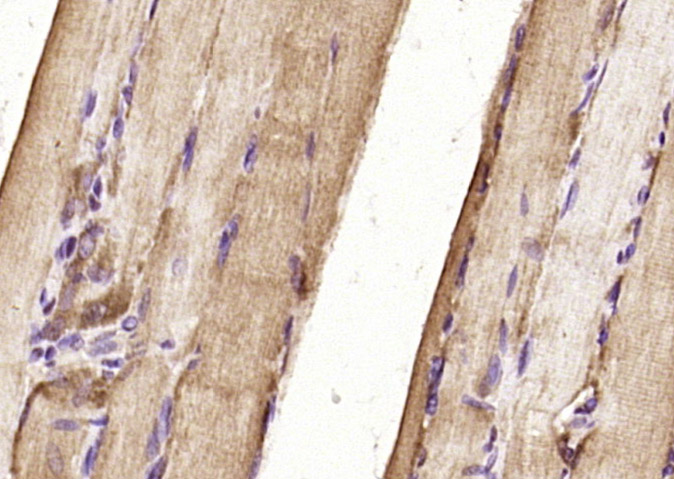
Rabbit Anti-UCHL3 antibody
Ubiquitin carboxyl-terminal hydrolase isozyme L3; Ubiquitin thioesterase L3; Ubiquitin thiolesterase; Ubiquitin thiolesterase L3; UCH L3; UCH-L3; UCHL3; UCHL3_HUMAN.
View History [Clear]
Details
Product Name UCHL3 Chinese Name Ubiquitin硫酯酶L3抗体 Alias Ubiquitin carboxyl-terminal hydrolase isozyme L3; Ubiquitin thioesterase L3; Ubiquitin thiolesterase; Ubiquitin thiolesterase L3; UCH L3; UCH-L3; UCHL3; UCHL3_HUMAN. literatures Research Area Cell biology Neurobiology Signal transduction Epigenetics Ubiquitin Alzheimer's Immunogen Species Rabbit Clonality Polyclonal React Species Rat, (predicted: Human, Mouse, Chicken, ) Applications WB=1:500-2000 ELISA=1:5000-10000 IHC-P=1:100-500 IHC-F=1:100-500 ICC=1:100-500 IF=1:100-500 (Paraffin sections need antigen repair)
not yet tested in other applications.
optimal dilutions/concentrations should be determined by the end user.Theoretical molecular weight 26kDa Cellular localization cytoplasmic Form Liquid Concentration 1mg/ml immunogen KLH conjugated synthetic peptide derived from human UCHL3: 133-230/230 Lsotype IgG Purification affinity purified by Protein A Buffer Solution 0.01M TBS(pH7.4) with 1% BSA, 0.03% Proclin300 and 50% Glycerol. Storage Shipped at 4℃. Store at -20 °C for one year. Avoid repeated freeze/thaw cycles. Attention This product as supplied is intended for research use only, not for use in human, therapeutic or diagnostic applications. PubMed PubMed Product Detail UCH-L1 is a member of a gene family whose products hydrolyze small C-terminal adducts of ubiquitin to generate the ubiquitin monomer. Expression of UCH-L1 is highly specific to neurons and to cells of the diffuse neuroendocrine system and their tumors. UCH-L1 is expressed in brain neurons. Examination of specific brain regions reveals expression in all areas tested, particularly in the substantia nigra. UCH-L1 represents 1 to 2% of total soluble brain protein. Its occurrence in Lewy bodies and its function in the proteasome pathway make it a compelling candidate gene in Parkinson disease. The gene which encodes UCH-L1 maps to human chromosome 4p14. The 230 amino acid human UCH-L3 protein is 54% identical to that of UCH-L1. UCH-L3 is the predominant thiol protease and has high-affinity binding sites for ubiquitin.
Function:
Deubiquitinating enzyme (DUB) that controls levels of cellular ubiquitin through processing of ubiquitin precursors and ubiquitinated proteins. Thiol protease that recognizes and hydrolyzes a peptide bond at the C-terminal glycine of either ubiquitin or NEDD8. Has a 10-fold preference for Arg and Lys at position P3". Deubiquitinates ENAC in apical compartments, thereby regulating apical membrane recycling. Indirectly increases the phosphorylation of IGFIR, AKT and FOXO1 and promotes insulin-signaling and insulin-induced adipogenesis. Required for stress-response retinal, skeletal muscle and germ cell maintenance. May be involved in working memory.
Subunit:
Preferentially binds diubiquitin; the interaction does not hydrolyze diubiquitin but, in vitro, inhibits the hydrolyzing activity on other substrates.
Subcellular Location:
Cytoplasm.
Tissue Specificity:
Highly expressed in heart, skeletal muscle, and testis.
Post-translational modifications:
Phosphorylated upon DNA damage, probably by ATM or ATR.
Similarity:
Belongs to the peptidase C12 family.
SWISS:
P15374
Gene ID:
7347
Database links:Entrez Gene: 7347 Human
Entrez Gene: 50933 Mouse
Omim: 603090 Human
SwissProt: P15374 Human
SwissProt: Q9JKB1 Mouse
Unigene: 162241 Human
Unigene: 275970 Mouse
Unigene: 145487 Rat
Product Picture
Bought notes(bought amounts latest0)
No one bought this product
User Comment(Total0User Comment Num)
- No comment




 +86 571 56623320
+86 571 56623320
 +86 18668110335
+86 18668110335

